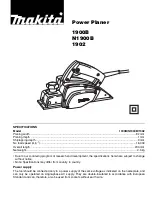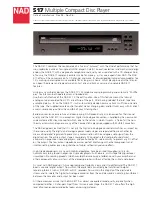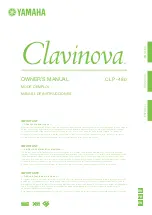
9
Shiplapping (Fig. 11, 12, 13 & 14)
To make a stepped cut as shown in
Fig. 11
, use the edge
fence (Standard equipment for 1900B and N1900B;
optional accessory for 1902).
Draw a cutting line on the workpiece. Insert the edge
fence into the hole in the front of the tool. Align the blade
edge with the cutting line.
Adjust the edge fence until it comes in contact with the
side of the workpiece, then secure it by tightening the
screw.
You may wish to add to the length of the fence by attach-
ing an extra piece of wood. Convenient holes are pro-
vided in the fence for this purpose, and also for attaching
an extension guide (optional accessory).
NOTE:
When planing, move the tool with the edge fence flush
with the side of the workpiece. Otherwise uneven planing
may result.
Max. shiplapping depth is 9 mm.
Chamfering (Fig. 15, 16 & 17)
To make a cut as shown in
Fig. 15
, align the “V” groove in
the front base with the edge of the workpiece and plane it
as shown in the
Fig. 17
.
Nozzle assembly (optional accessory)
(Fig. 18 & 19)
Use of the special nozzle assembly will minimize chip
scatter, making for a cleaner work area.
The nozzle assembly may be attached after the chip
cover on the tool body is removed. When slipping on the
assembly, fit the pin on it into the rear cover hole. Use the
chip cover screws to fasten it in place.
Sharpening the planer blades (Fig. 20, 21 & 22)
For standard blades only
Always keep your blades sharp for the best performance
possible. Use the sharpening holder to remove nicks and
produce a fine edge.
First, loosen the two wing nuts on the holder and insert
the blades (A) and (B), so that they contact the sides (C)
and (D). Then tighten the wing nuts.
Immerse the dressing stone in water for 2 or 3 minutes
before sharpening. Hold the holder so that the blades
both contact the dressing stone for simultaneous sharp-
ening at the same angle.
MAINTENANCE
CAUTION:
Always be sure that the tool is switched off and
unplugged before carrying out any work on the tool.
Replacing carbon brushes (Fig. 23, 24 & 25)
Remove and check the carbon brushes regularly.
Replace when they wear down to the limit mark. Keep
the carbon brushes clean and free to slip in the holders.
Both carbon brushes should be replaced at the same
time. Use only identical carbon brushes.
Use a screwdriver to remove the chip cover. Use a screw-
driver to remove the brush holder caps. Take out the
worn carbon brushes, insert the new ones and secure
the brush holder caps.
To maintain product SAFETY and RELIABILITY, repairs,
any other maintenance or adjustment should be per-
formed by Makita Authorized or Factory Service Centres,
always using Makita replacement parts.
Содержание 1900B
Страница 2: ...2 1 2 3 4 5 6 7 8 4 1 5 3 2 8 11 5 7 3 6 9 10 12 5 15 13 14 11 16 17 18 9 12 18 2 16 4 1 19 20 21 20...
Страница 3: ...3 22 20 24 23 25 26 27 28 29 30 9 10 11 12 13 14 15 16...
Страница 4: ...4 31 32 34 35 33 36 37 39 41 38 40 34 43 42 17 18 19 20 21 22 23 24...
Страница 10: ...10...
Страница 11: ...11...
Страница 12: ...Makita Corporation Anjo Aichi Japan Made in Japan 883185G5...






























